This homemade blueberry liqueur, made with fresh blueberries, is a must-have in a homemade liqueur collection. Its vibrant purple hue and tantalizing taste add an intense flavor of wild blueberries to fruity cocktails and punches. You can also enjoy it as an after-dinner treat, cold with a hint of lime juice. Craft your blueberry liqueur and present it as a delightful edible gift to your loved ones.
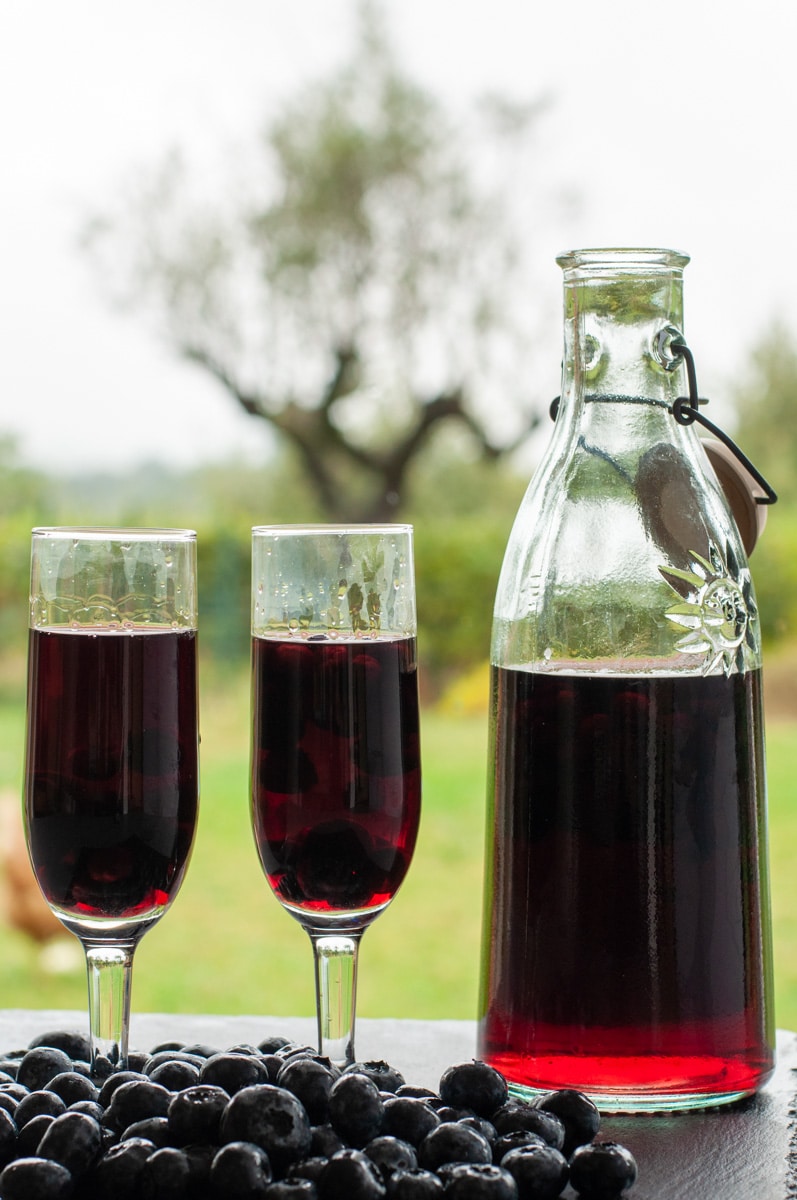
Jump to:
Fruit liqueurs have ancient roots, originating from old-world traditions of infusing spirits with nature's bounty.
Among them, the sweet liqueur of blueberries stands out, a testament to the blend of history and rich North American heritage.
Making this delightful drink requires little patience, but the results are utterly rewarding.
As a homemade edible gift, the blueberry liqueur is unparalleled.
It tells a story of tradition and taste and offers endless possibilities in cocktail recipes.
For those looking to impress or share a piece of history infused with flavor, this sweet liqueur makes for awesome gifts.
Whether enjoyed neat, mixed in a cocktail, or introduced in culinary delights, it's a gift that resonates with sophistication and love.
For more homemade liqueurs, you can check out the article: Homemade liqueurs, where you can find classics like Limoncello and more fruit liqueurs like Strawberry and Orange Curacao.
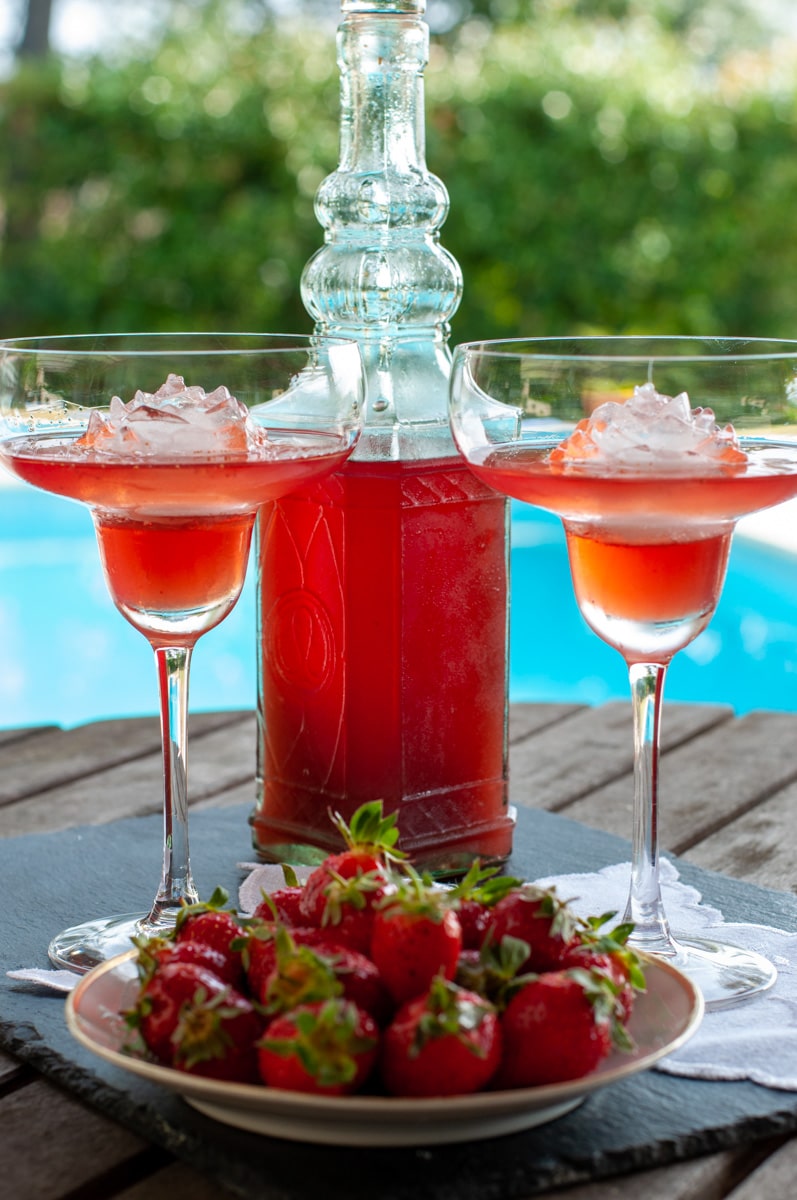
Ingredients
While crafting this blueberry liqueur, patience is the key.
The process may be time-consuming, but the result is worth the wait.
Here's what you need:
Ripe Blueberries
Choosing fresh over frozen is vital. Fresh blueberries, especially the Icelandic blueberries known for their intense flavor and deep color, provide robustness and authenticity to the liqueur that frozen berries cannot match.
While freezing preserves many nutrients, it can alter the texture and compromise some of the berry's natural flavors, which are critical in achieving that sublime balance in liqueurs.
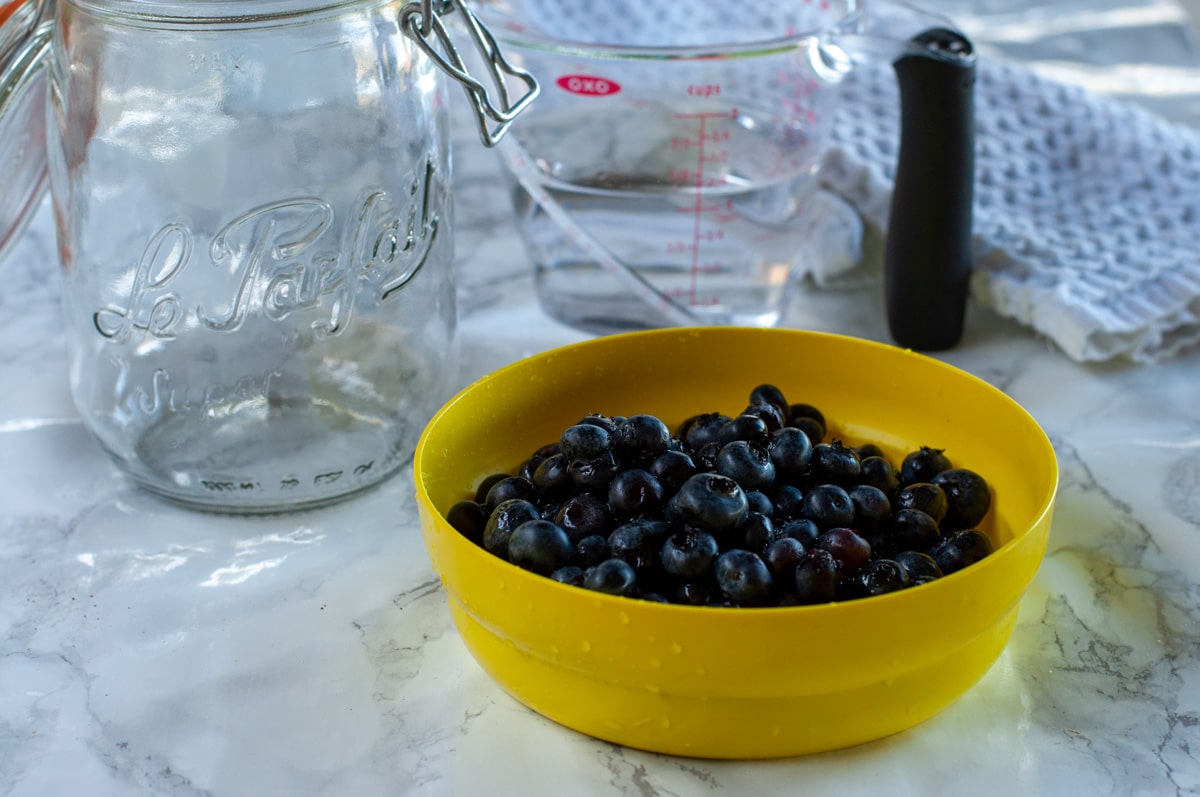
The other ingredients
- 95% drinkable alcohol: Everclear is an option in the USA. Alternatively, you can opt for Vodka.
- Granulated sugar: To craft a simple syrup.
- Freshwater: Use bottled water if tap water has an off taste
See recipe card for measurements
Instructions
Brewing the blueberries
- Wash the blueberries.
- Place them into a 2-liter canning jar
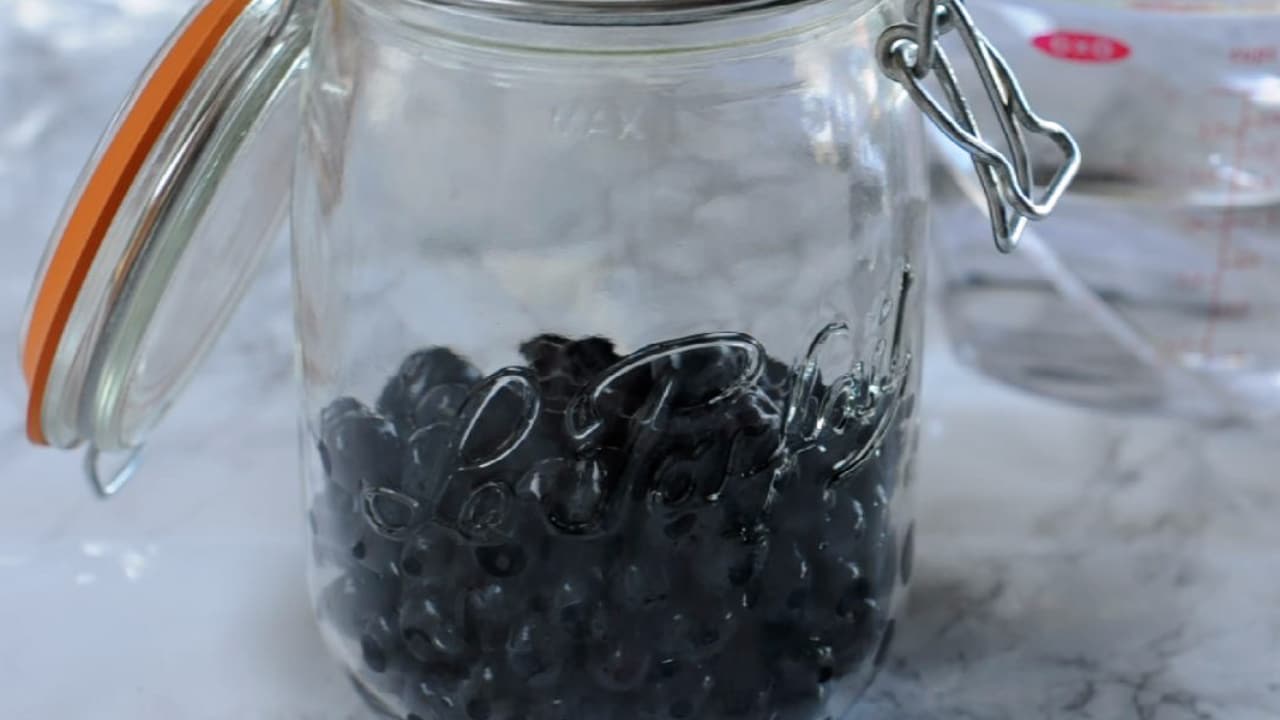
- Cover with the alcohol and mix well.
- Store in a cool, dark place for 10 days, shaking every other day.
Hint: you can blend some of the berries, but I like to use them whole as I leave them in the liqueur bottle. Seeing these berries in the bottle adds a touch of natural elegance and allure to the drink
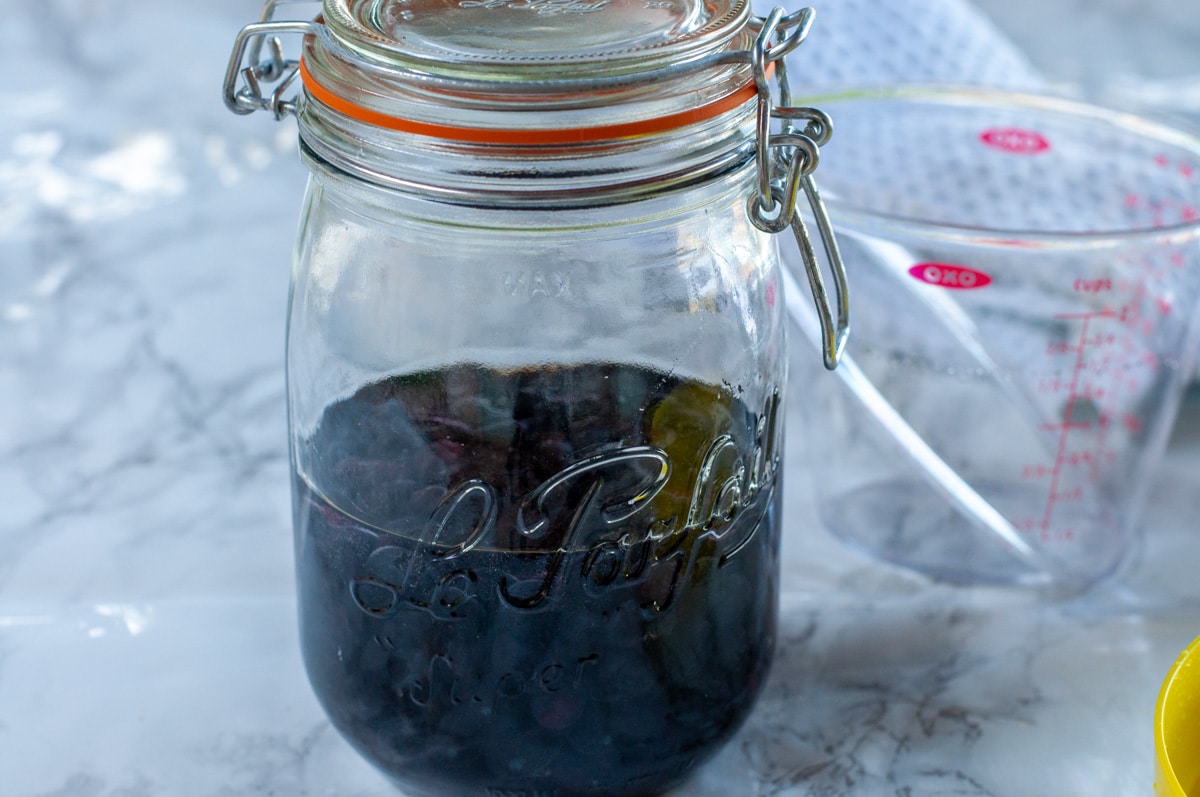
Adding the sugar syrup
- After 10 days, prepare the syrup by dissolving sugar in water on the stove.
- Allow the syrup to cool.
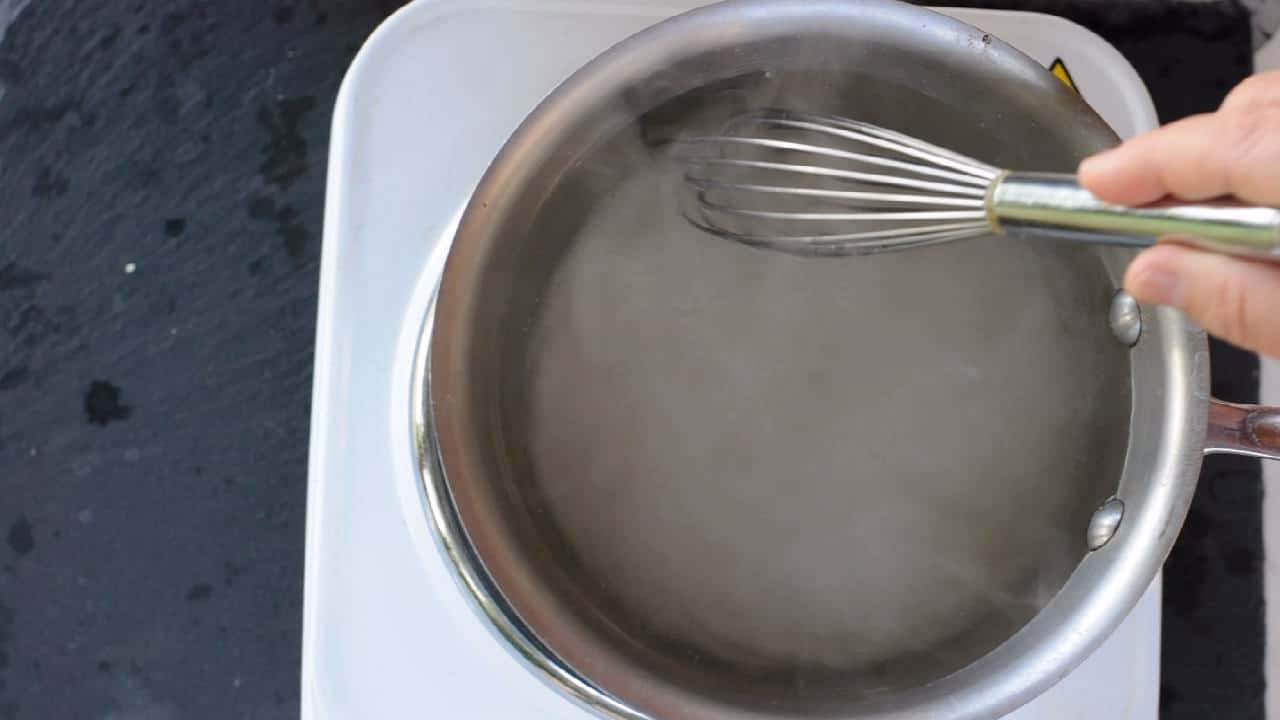
- In a large-neck 1-gallon glass bottle, combine the syrup and the blueberry-alcohol mixture.
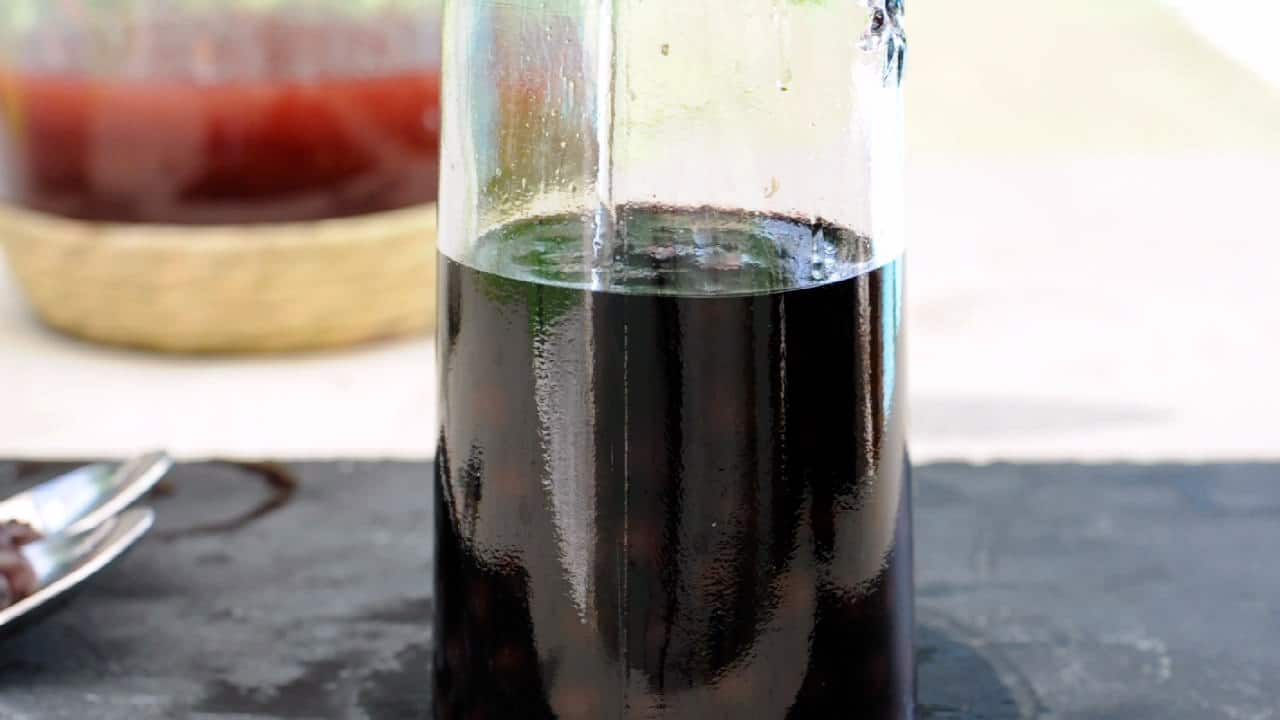
- Let it sit for an additional 20 days, shaking occasionally.
- Transfer the liqueur into decorative bottles and store them in a cool place.
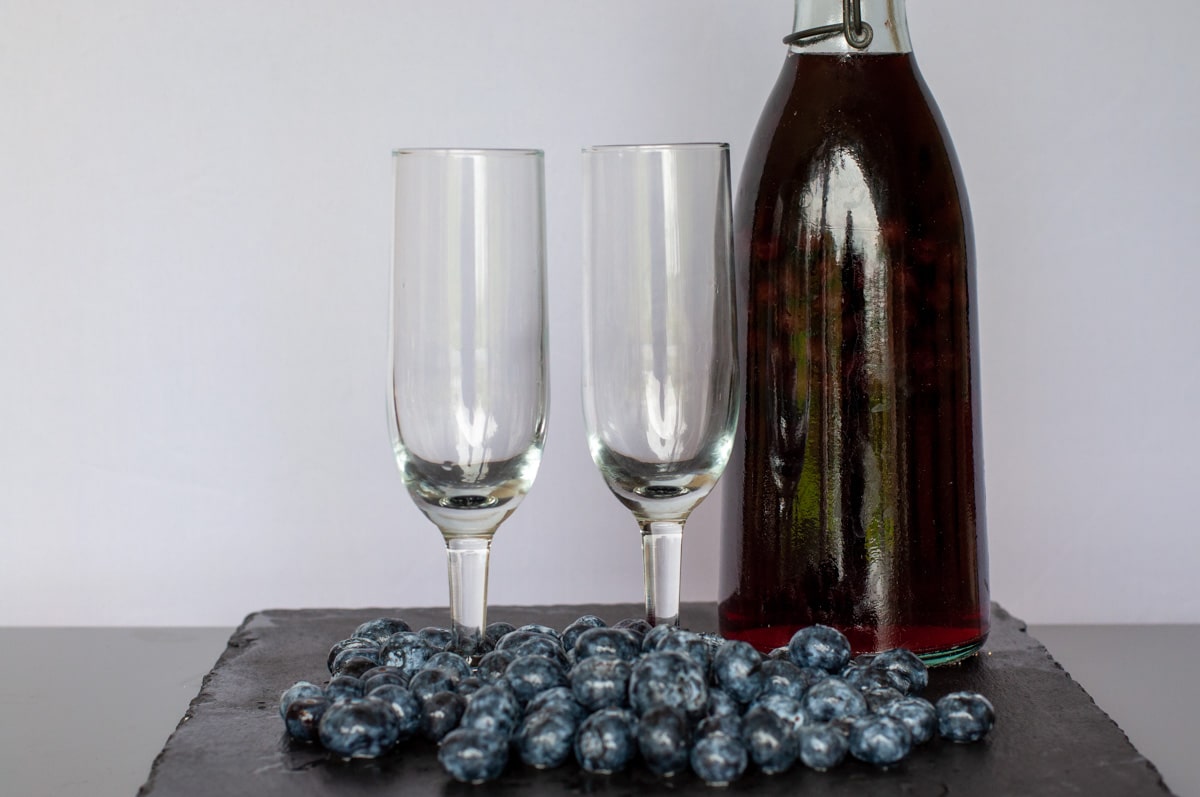
Serving suggestions
Serve blueberry liqueur chilled for an optimal tasting experience.
Keep it in a dark bottle in your refrigerator before serving.
This enhances its intricate flavors and ensures it's at the right temperature to be enjoyed straight or as a part of cocktails.
Here are some ideas on how to serve it:
Pairing with Other Beverages
- Combine your blueberry liqueur with your gin for a refreshing cocktail. The gin's juniper notes beautifully complement the liqueur's fruity essence.
- Create a sophisticated spritzer by adding a splash of blueberry liqueur to your favorite white wine, elevating its flavors, and adding a touch of sweetness.
- Mix blueberry liqueur with a hard seltzer made with fermented cane sugar for a fizzy delight. It's a trendy choice in the United States, offering a bubbly yet light beverage experience.
Garnishes and Presentation Ideas
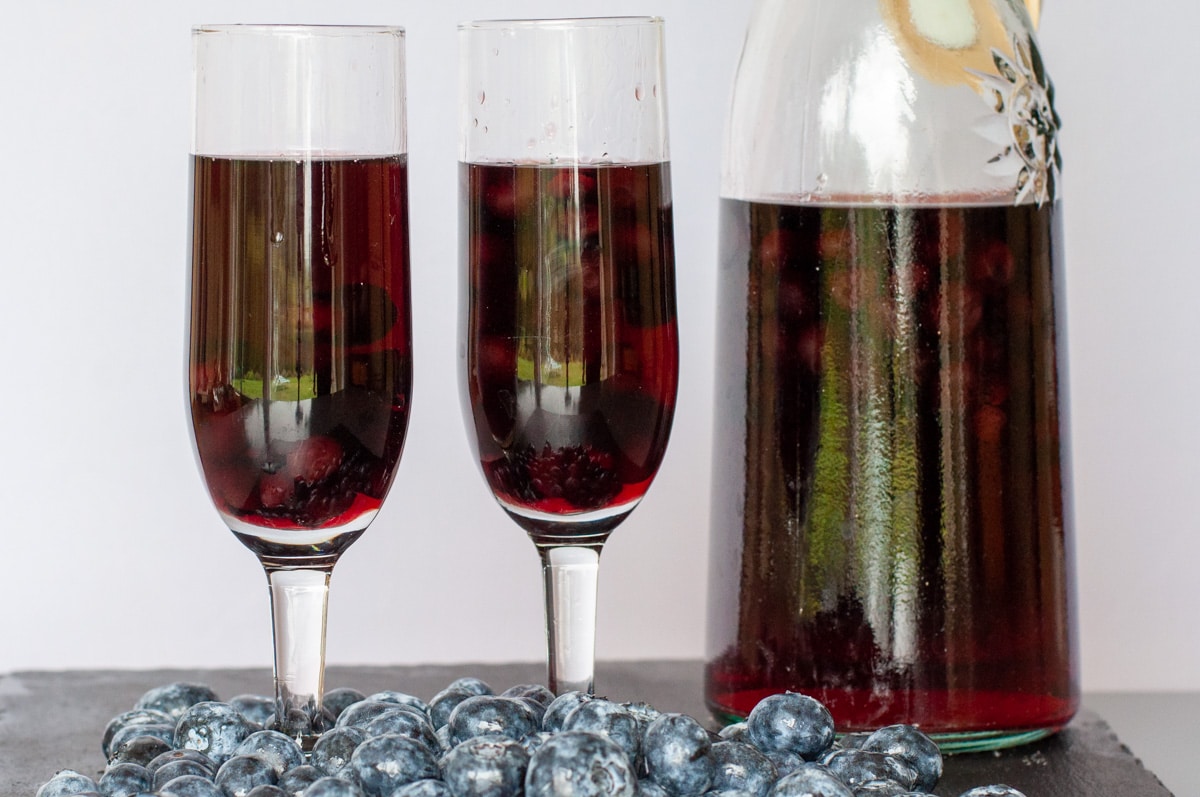
- Vanilla Ice Cream: Drizzle blueberry liqueur over a scoop of vanilla ice cream for an indulgent dessert. The liqueur's deep blueberry tones enrich the creamy vanilla flavor, making it a dessert to remember.
- Cocktail Glass: For an elegant presentation, serve the liqueur in a cocktail glass with an orange or lemon peel twist. The citrusy aroma heightens the drink's appeal.
- Glass Jar: For a rustic feel, especially if gifting as an individual item, bottle the liqueur in a glass jar. This adds a personal touch reminiscent of homemade treasures.
- Rocks Glass: Serving straight liqueur in a rocks glass, perhaps with a single ice cube, showcases its purity and richness.
- Cocktail Stick: For an added touch of sophistication, skewer fresh blueberries on a cocktail stick and place it in your drink as an aesthetic and tasty garnish.
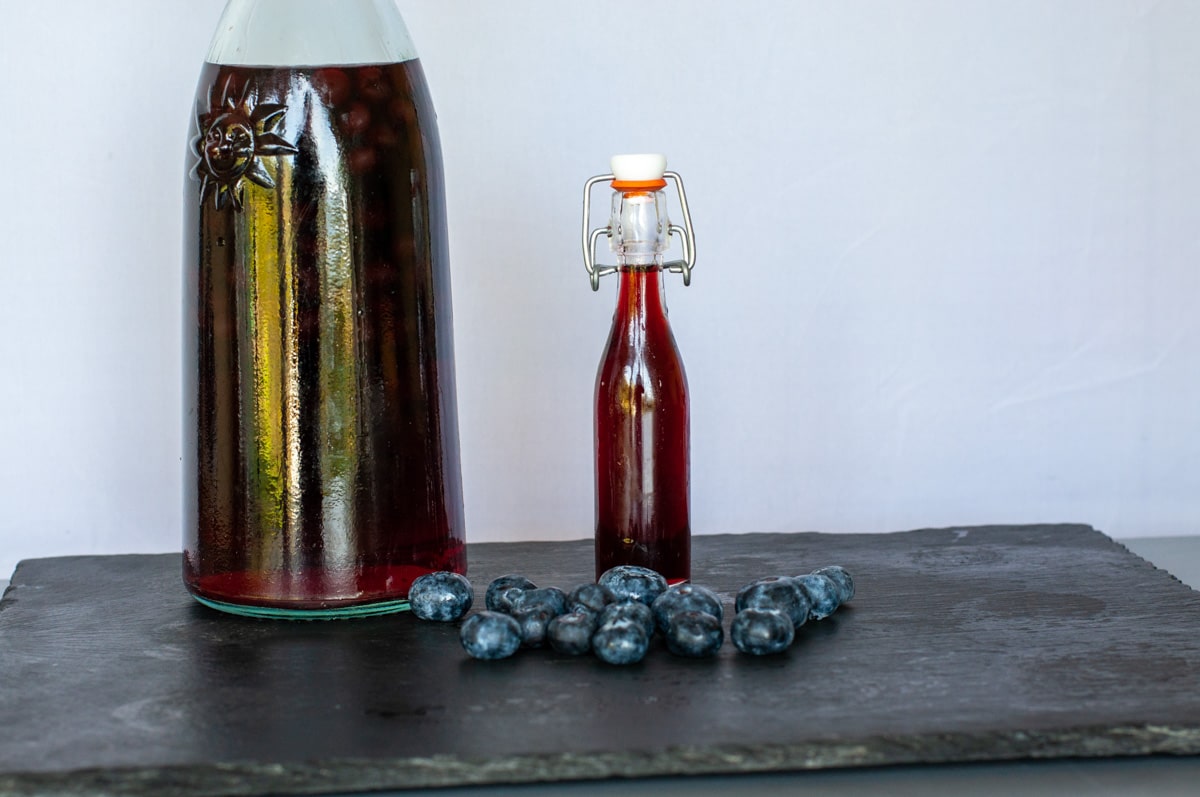
Storing and Shelf Life
To maintain the quality and vibrancy of your blueberry liqueur, store it in a cool, dark place, preferably in a dark bottle or glass container.
Direct sunlight or extreme temperatures can adversely affect its flavor and color.
Always seal the bottle or container tightly to prevent air from diminishing quality.
While the liqueur may remain safe for over a year, its peak flavor and aroma are most prominent in the first few months.
A historic view
The tradition of infusing spirits with fruits, herbs, and spices traces back thousands of years.
Civilizations from ancient China to the Middle East and Europe have long practiced flavoring alcohol with many botanicals.
Initially, many of these infusions were medicinal, as alcohol was deemed a potent solvent for extracting the therapeutic properties of plants.
The Greeks, for instance, have historical mentions of flavored wines, and by the time of the Renaissance, alchemical distillations had given birth to the precursors of what we know today as liqueurs.
Fruit liqueurs, specifically, gained prominence in Europe during the Middle Ages.
Monasteries, with their vast herb gardens, often took on the role of distillers.
Monks would combine seasonal fruits with brandy or other spirits, not only to preserve the flavors but also to create beverages that were believed to have healing properties.
Over time, as these elixirs left the confines of the monastic walls, they became sought-after commodities in European high society.
Evolution of Blueberry-based Beverages
The humble blueberry, native to North America, is deeply ingrained in the continent’s cultural and culinary history.
Indigenous tribes celebrated the tiny berry for its nutritional benefits and symbolic meanings, often consuming them fresh, dried, or mixed into traditional dishes.
It wasn't until the blueberry was introduced to European settlers that its potential in beverages began to be explored on a broader scale.
Initially, blueberries found their way into wines, teas, and other non-alcoholic concoctions.
The evolution into liqueurs came naturally as the settlers merged their European distilling traditions with the bountiful native fruits of the New World.
The 20th century saw a significant rise in the popularity of blueberry-based beverages.
With advancements in cultivation, specifically the development of highbush blueberries in the early 1900s, there was increased availability of the fruit.
This abundance allowed distillers to experiment more freely, leading to the birth of various blueberry liqueurs that combined the rich, tart flavor of the berry with the warm depth of spirits.
Today, blueberry liqueurs hold a special significance in the world of beverages.
They symbolize the marriage of the Old World, distilling traditions with the unique flavors of the New World.
Whether sipped neat, mixed in cocktails, or drizzled over desserts, blueberry liqueurs capture the essence of a fruit that has journeyed through time and across continents.
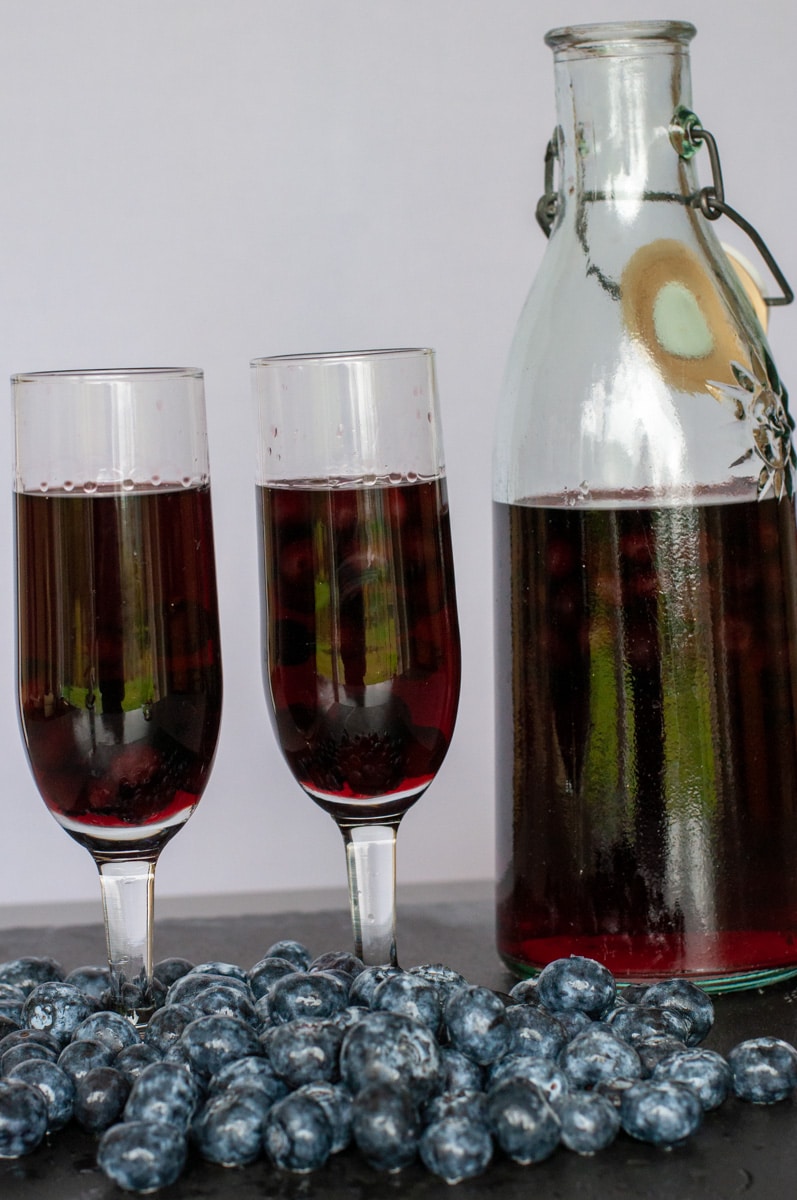
No risk of botulism
Since a reader asked, I would like to reassure everyone who has doubts, this liqueur is not at risk of botulism. This recipe uses Alcohol 95% or vodka 50% of ethanol.
A study proves botulism cannot grow in Alcohol: ”The growth and neurotoxin production (botulism) was delayed by an ethanol concentration of 4% ethanol and completely inhibited by a concentration of 6%”.
Effect of Ethanol on the growth of Colstridium botulinum
Botulism concerns home canning… not fermentation or infusions of fruits and vegetables. Here is more information about botulism from the USDA Food Safety and Inspection Service:
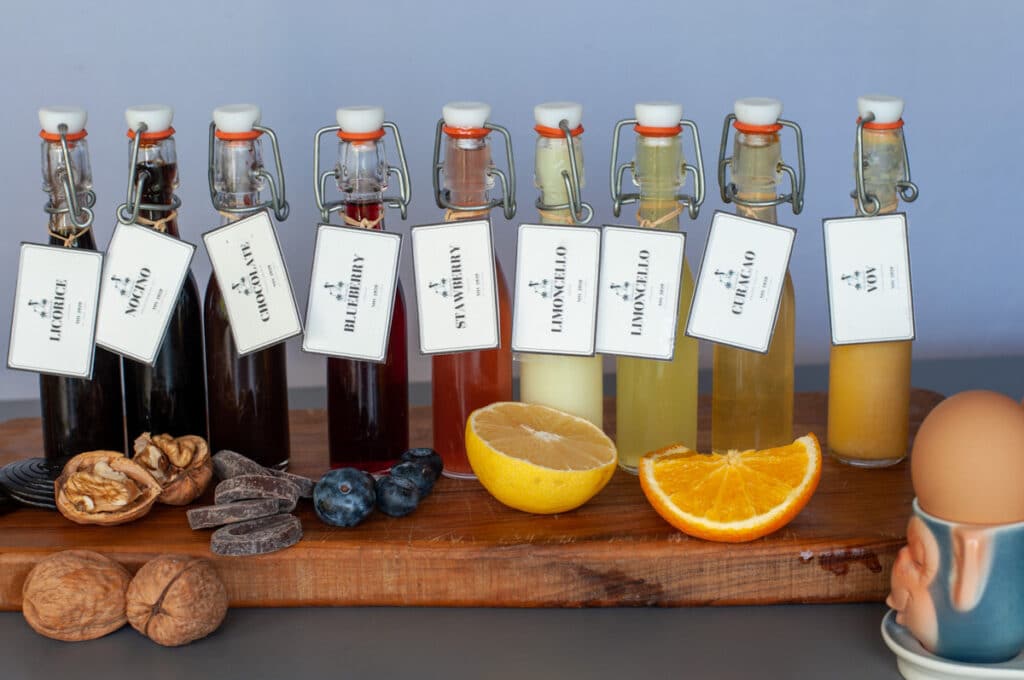
Setting up a liqueur workshop
You can easily create your liqueur workshop with just a few items. They are not expensive and you can order them online from my Amazon shop: Homemade Liqueur Lab. Those are my favorite and specially selected tools to make the process smooth and easy:
- Jars 67 ounce - 2 liters: I use large canning jars to infuse herbs or fruits in the alcohol. They are easily sealed and don't take much room in the cupboard. I usually brew different types of liqueurs at the same times so I need several jars. If you are an occasional liqueur maker, you can just use the bottle below.
- 1 gallon - 3-liters glass bottle: I use this bottle in the second part of the brewing process, once I add the syrup. It is a transparent glass bottle so I can check how the liqueur is progressing and if it needs a good shake. It is important that this bottle has a large neck so the residuals of the fruits, zests, spices, or herbs can be easily removed without any problem once the liqueur is ready to be bottled. Personally I have 2 of those large bottles.
- Funnel with a wide and short stem: When you are pouring the liqueur from one bottle to another during the brewing process, you need to have a funnel with a wide and short stem so it doesn't get clog with the ingredients that are brewing in the alcohol.
- Auto-stop funnel: However, once the liqueur is ready, filtered and all the solid particles have been removed, I like to use an auto-stop funnel with a floating system that stops the liquid from flowing once the bottled has been filled.
It is very difficult to gauge how much liquid can fit in a bottle and I often fill the funnel way too much. Instead of overflowing the bottle, the auto-stop funnel locks the stem automatically and the excess liquid remains in the funnel.
The funnel can be easily removed, transferred into another bottle using the handle that keeps the liquid inside the funnel and no liqueur is wasted.
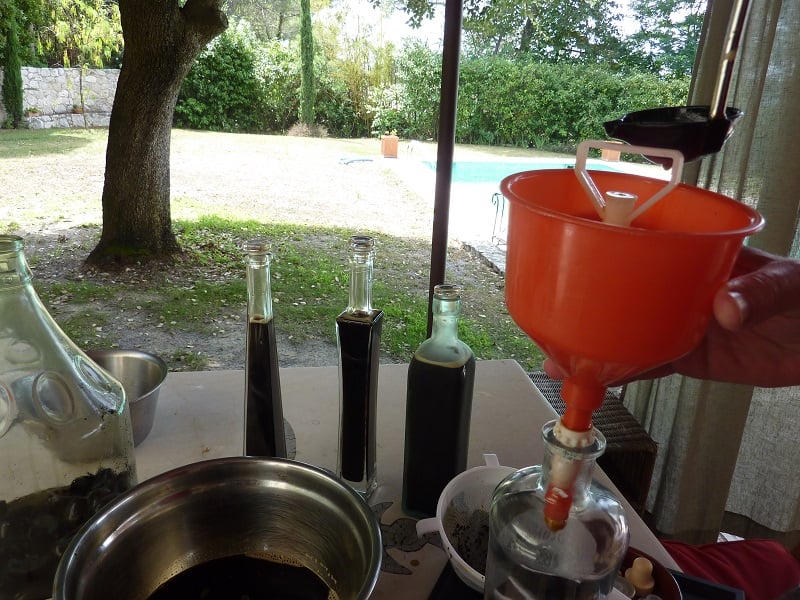
- Fine Mesh Strainer: to remove all solids and particles from the liqueur once it is ready to be filtered.
- Measuring mugs: it is very important to use the exact proportion of syrup vs alcohol. Measurements mugs are a must.
- Ladle with spout: to easily pour the liquid into the funnels from a large bowl or pan. I always use the ladle with a spout to take the syrup from the pan where I boiled it into the funnel. If you don't have a pan with a spout, this is the easiest way to pour the syrup once it is cold.
- Fancy vintage bottles: I love to have my own liqueur assortment into those vintage bottles. It gives my homemade liqueurs an extra wow factor.
- Small glass bottles with lids: if you want to store the liqueurs in small bottles or if you want to give it as gifts to friends and family those small bottles are perfect. The lid seals and they can be easily carried. They even come with labels to write the name of the liqueur and the date.
- Shot glass set and/or Small liqueur glasses: it is very important to serve the liqueur in small shot glasses so it can be slowly sipped and relished.
- Good Grips Bottle Brush: to easily clean all the bottles after each use. Some liqueurs can be very sticky and stain easily like the walnut hull.
- If you want to give your liqueur an extra festive look you can also use the Rose Ice Cube Stackable to make rose ices or the ice cube with light to make your liqueur shine at night.

My selection of liqueurs
Here are some liqueurs I've crafted over the years:
- Classic Limoncello
- Creamy limoncello cream
- Fruity strawberry liqueur
- Nutty Nocino
- Decadent chocolate liquor
- Versatile orange liqueur curacao
- Natural Licorice liqueur
- Festive Italian eggnog VOV
- Spring-inspired violet liqueur
For more, see the "Homemade liquors" section. If you're looking for something a bit different, try the Concord Grape Wine Fragolino.
Made with grapes reminiscent of strawberries, it's an exotic brew to explore.
However, it's essential to note that this is for personal consumption only due to European restrictions.
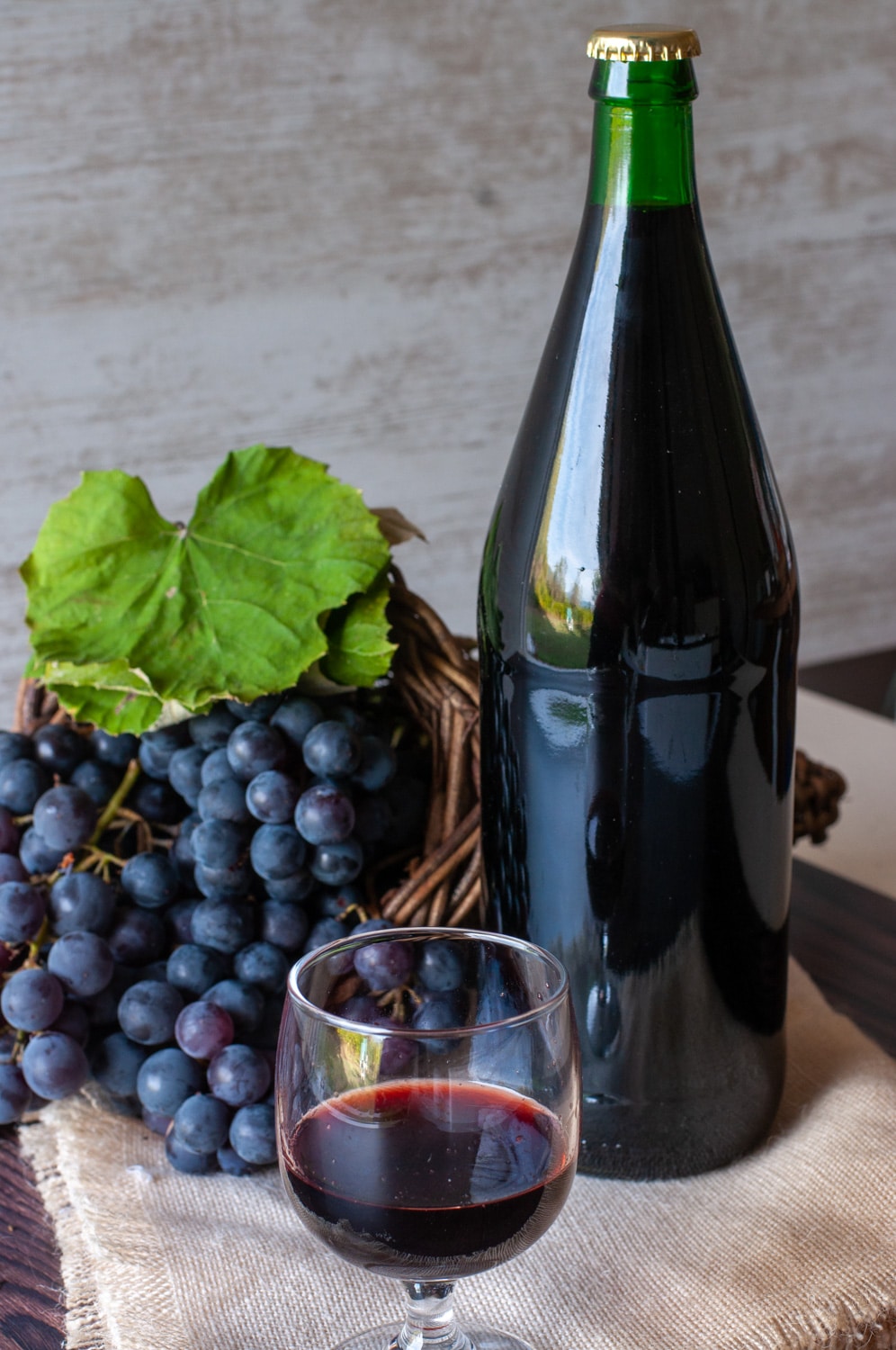
If you are making any of this blueberry liqueur, leave your comment below I would like to hear from you. You can find more delicious ideas if you FOLLOW ME on Facebook, YouTube, or sign up to my newsletter.
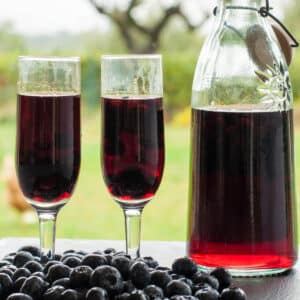
📋 Italian Homemade Blueberry Liqueur Recipe
Ingredients
- 1 ¼ cup 95% alcohol or vodka
- 10 oz blueberries
- 1 ½ cup sugar
- ½ cup water
Equipment
Instructions
Brewing the blueberries
- Wash the blueberries.10 oz blueberries
- Place them into a 2-liter canning jar
- Cover with the alcohol and mix well.1 ¼ cup 95% alcohol or vodka
- Store in a cool, dark place for 10 days, shaking every other day.
Adding the sugar syrup
- After 10 days, prepare the syrup by dissolving sugar in water on the stove1 ½ cup sugar, ½ cup water
- Allow the syrup to cool.
- In a large-neck 1-gallon glass bottle, combine the syrup and the blueberry-alcohol mixture.
- Let it sit for an additional 20 days, shaking occasionally.
- Transfer the liqueur into decorative bottles and store them in a cool place.
Notes
- you can blend some of the berries, but I like to use them whole as I leave them in the liqueur bottle. Seeing these berries in the bottle adds a touch of natural elegance and allure to the drink
- Serve blueberry liqueur chilled for an optimal tasting experience.
- Keep it in a dark bottle in your refrigerator before serving.
Nutrition


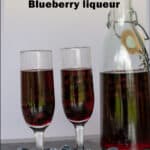
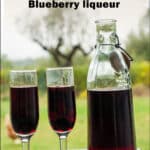
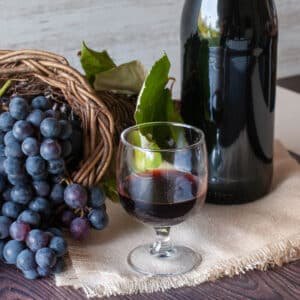
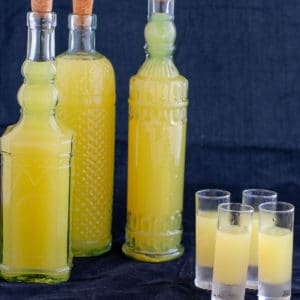
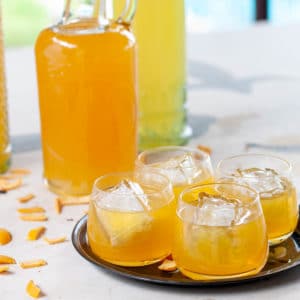
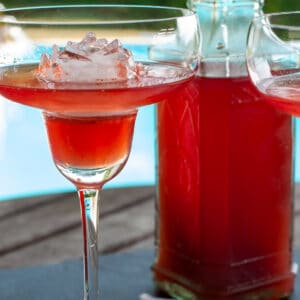
Leave a Reply